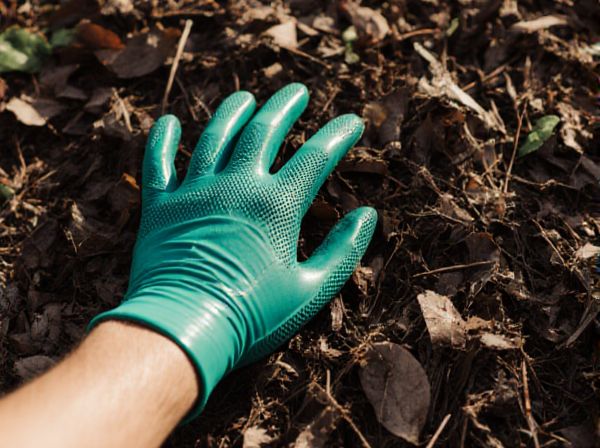
Plastic mulch vs Rubber mulch Illustration
Plastic mulch provides excellent weed control and moisture retention but can contribute to environmental pollution due to its non-biodegradable nature. Rubber mulch offers durability and effective weed suppression while improving soil aeration, with the added benefit of being made from recycled materials. Choosing between plastic and rubber mulch depends on balancing environmental impact, longevity, and specific gardening needs.
Table of Comparison
| Feature | Plastic Mulch | Rubber Mulch |
|---|---|---|
| Material | Polyethylene or biodegradable plastic | Recycled rubber, usually from tires |
| Durability | 1-3 years depending on type | Up to 10 years; highly durable |
| Water Permeability | Low to none; water runs off | Permeable; allows water to pass |
| Weed Control | Excellent weed barrier | Good weed suppression |
| Environmental Impact | Non-biodegradable; pollution concerns | Recycled material; environmentally friendly |
| Cost | Low initial cost | Higher initial cost |
| Installation | Lightweight but can tear | Heavier; requires more effort |
| Appearance | Shiny, varies by color | Natural look with dark colors |
Introduction to Plastic Mulch vs Rubber Mulch
Plastic mulch offers superior weed control and moisture retention due to its impermeable surface, making it ideal for high-value crops and commercial farming. Rubber mulch, derived from recycled tires, provides excellent durability and insulation while promoting soil aeration and reducing erosion, suitable for landscaping and playgrounds. Both materials serve unique purposes in agriculture and horticulture, with plastic mulch excelling in crop yield enhancement and rubber mulch in environmental sustainability and cushioning.
Material Composition and Manufacturing
Plastic mulch is primarily made from polyethylene, a synthetic polymer derived from petroleum, offering durability and water resistance through extrusion or blown-film processes. Rubber mulch consists of recycled tires shredded into granules, providing elasticity and long-lasting cushioning produced by mechanical shredding and granulation. The manufacturing of plastic mulch emphasizes uniform thickness and UV stabilization, while rubber mulch production involves shredding, magnetic separation, and sometimes coloring for enhanced aesthetic appeal.
Durability and Longevity Comparison
Plastic mulch offers high durability due to its resistance to moisture, UV rays, and pests, lasting typically 2-3 growing seasons before replacement is needed. Rubber mulch surpasses plastic mulch in longevity, often enduring up to 10 years without significant degradation due to its elastic properties and resistance to environmental wear. The choice between plastic and rubber mulch hinges on balancing initial effectiveness with long-term durability, where rubber mulch provides a more sustainable and cost-effective option over time.
Weed Suppression Effectiveness
Plastic mulch provides superior weed suppression by creating an impermeable barrier that blocks sunlight, preventing weed seed germination and growth. Rubber mulch, while durable and eco-friendly, allows some light penetration and air flow, which can enable certain weeds to emerge. Studies show plastic mulch reduces weed density by up to 90%, making it more effective for intensive agricultural weed control compared to rubber mulch.
Impact on Soil Temperature and Moisture
Plastic mulch significantly raises soil temperature by absorbing and retaining heat, promoting faster seed germination and earlier crop development. Rubber mulch, with its porous structure, provides moderate insulation, maintaining more stable soil moisture levels without overheating the soil. Both mulches help reduce evaporation, but plastic mulch excels in warming the soil while rubber mulch better preserves moisture balance in variable climates.
Environmental Impact and Sustainability
Plastic mulch contributes to soil degradation and microplastic pollution due to its non-biodegradable nature and often ends up in landfills or waterways. Rubber mulch, typically derived from recycled tires, offers a more sustainable alternative by repurposing waste materials and reducing landfill burden, though concerns remain about potential chemical leaching. Biodegradability and lifecycle impact assessments are critical factors in determining the overall environmental sustainability of mulch options.
Cost Analysis: Upfront vs Long-Term
Plastic mulch has a lower upfront cost compared to rubber mulch, making it more accessible for large-scale farming operations. However, rubber mulch offers longer durability and reduces replacement frequency, resulting in lower long-term expenses. When factoring maintenance, environmental impact, and lifespan, rubber mulch can provide a more cost-effective solution despite its higher initial investment.
Aesthetic Appeal and Garden Design
Plastic mulch offers a sleek, uniform look that enhances modern garden designs by providing clean lines and consistent color, often available in black, red, or clear shades. Rubber mulch, made from recycled tires, introduces a more natural texture and a variety of earthy colors that blend well with garden beds and landscaping elements. Both options improve aesthetic appeal, but plastic mulch suits contemporary styles while rubber mulch complements rustic or natural garden themes.
Safety and Toxicity Concerns
Plastic mulch poses potential safety and toxicity risks due to the release of harmful chemicals like phthalates and heavy metals when exposed to sunlight and heat. Rubber mulch, often made from recycled tires, contains volatile organic compounds (VOCs) and heavy metals that may leach into soil, raising concerns for plant health and human safety. Choosing mulch with verified non-toxic certification and proper installation can mitigate these hazards in gardening and landscaping applications.
Best Applications for Plastic and Rubber Mulch
Plastic mulch excels in controlling weeds, retaining soil moisture, and warming the soil, making it ideal for vegetable gardens, row crops, and high-value fruit production. Rubber mulch is best suited for playgrounds, landscaping, and erosion control due to its durability, cushioning properties, and long lifespan. Choosing between plastic and rubber mulch depends on specific garden needs such as crop type, environmental conditions, and intended use.
Plastic mulch vs Rubber mulch Infographic

 gardendif.com
gardendif.com